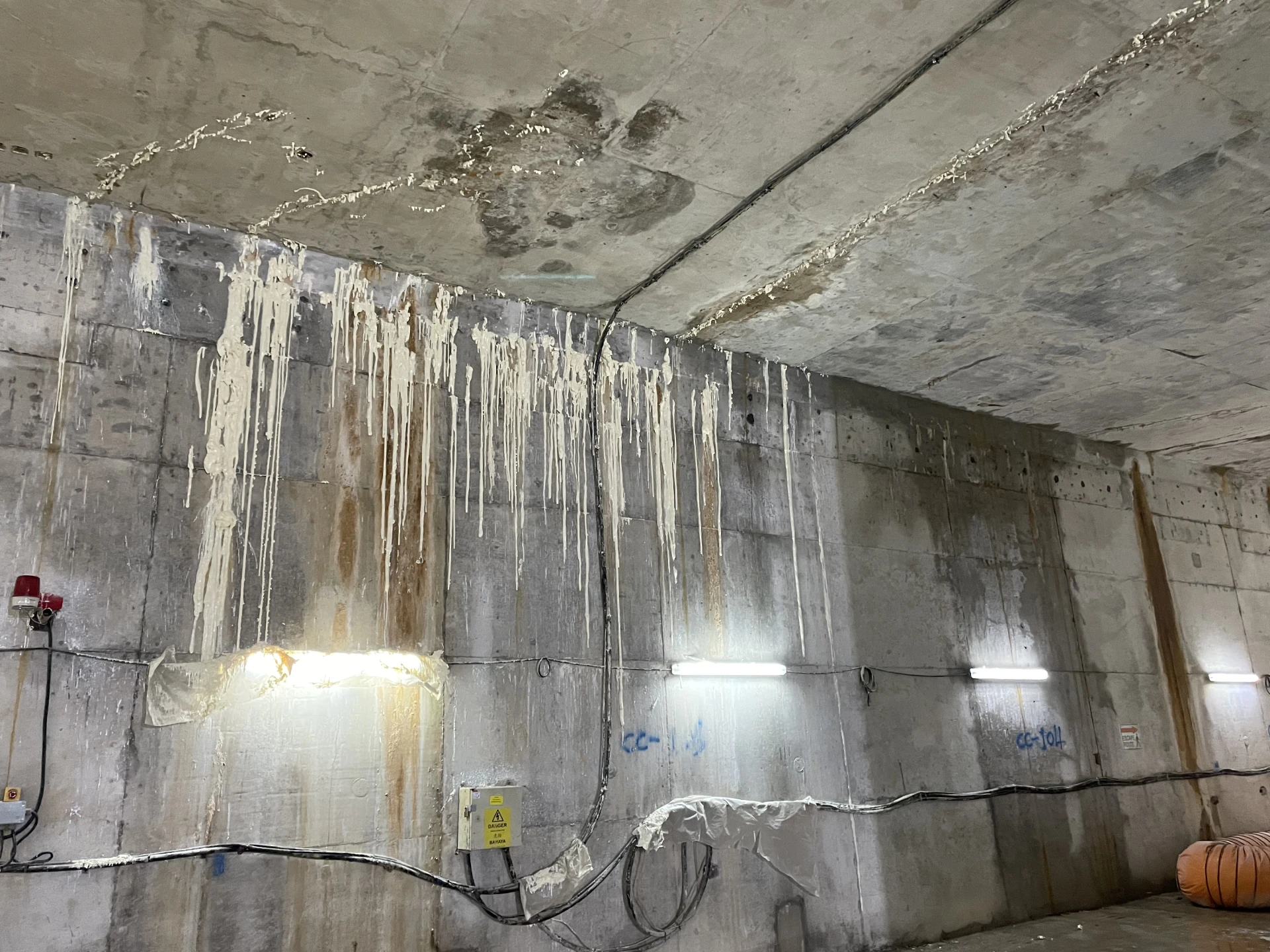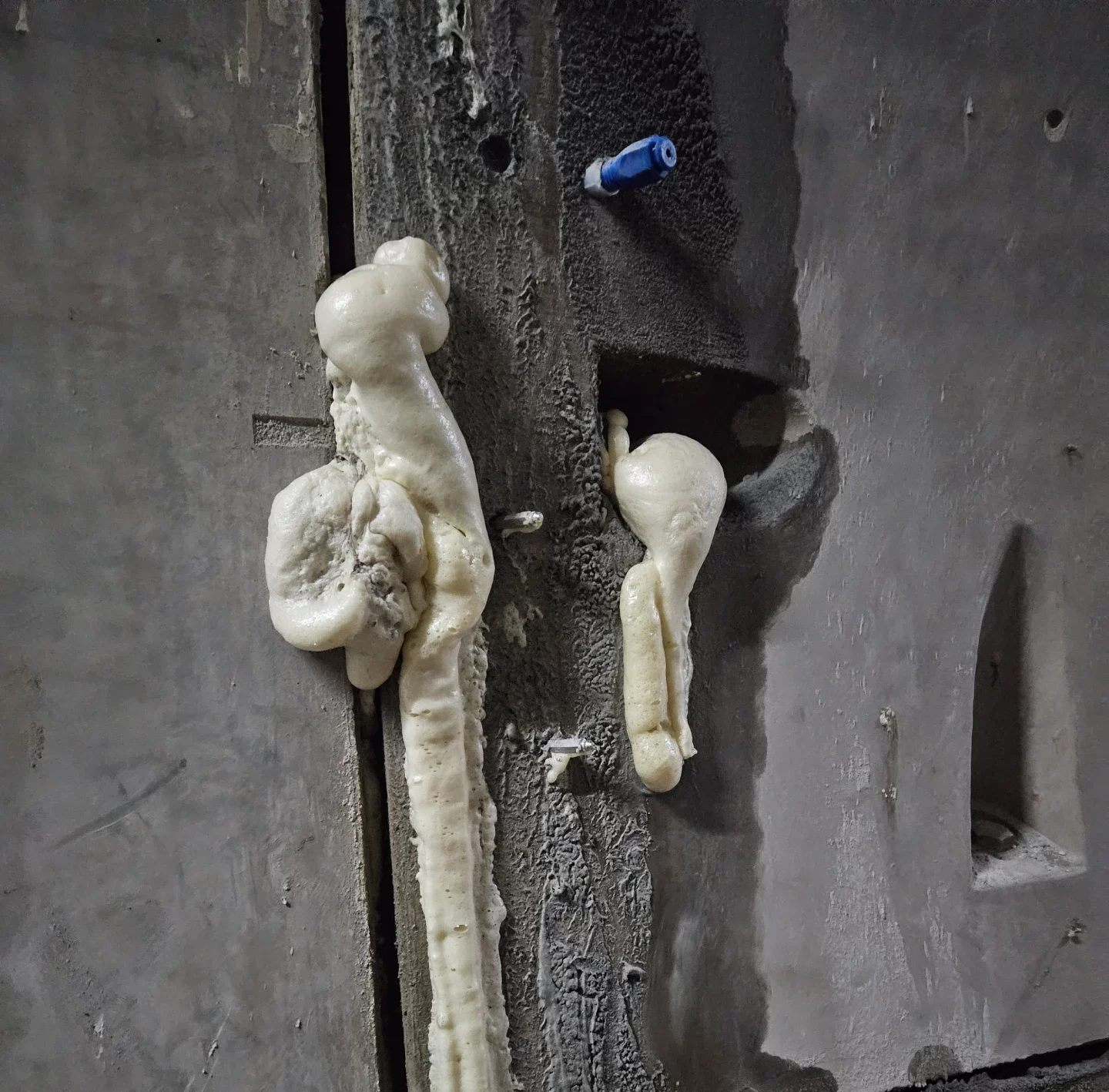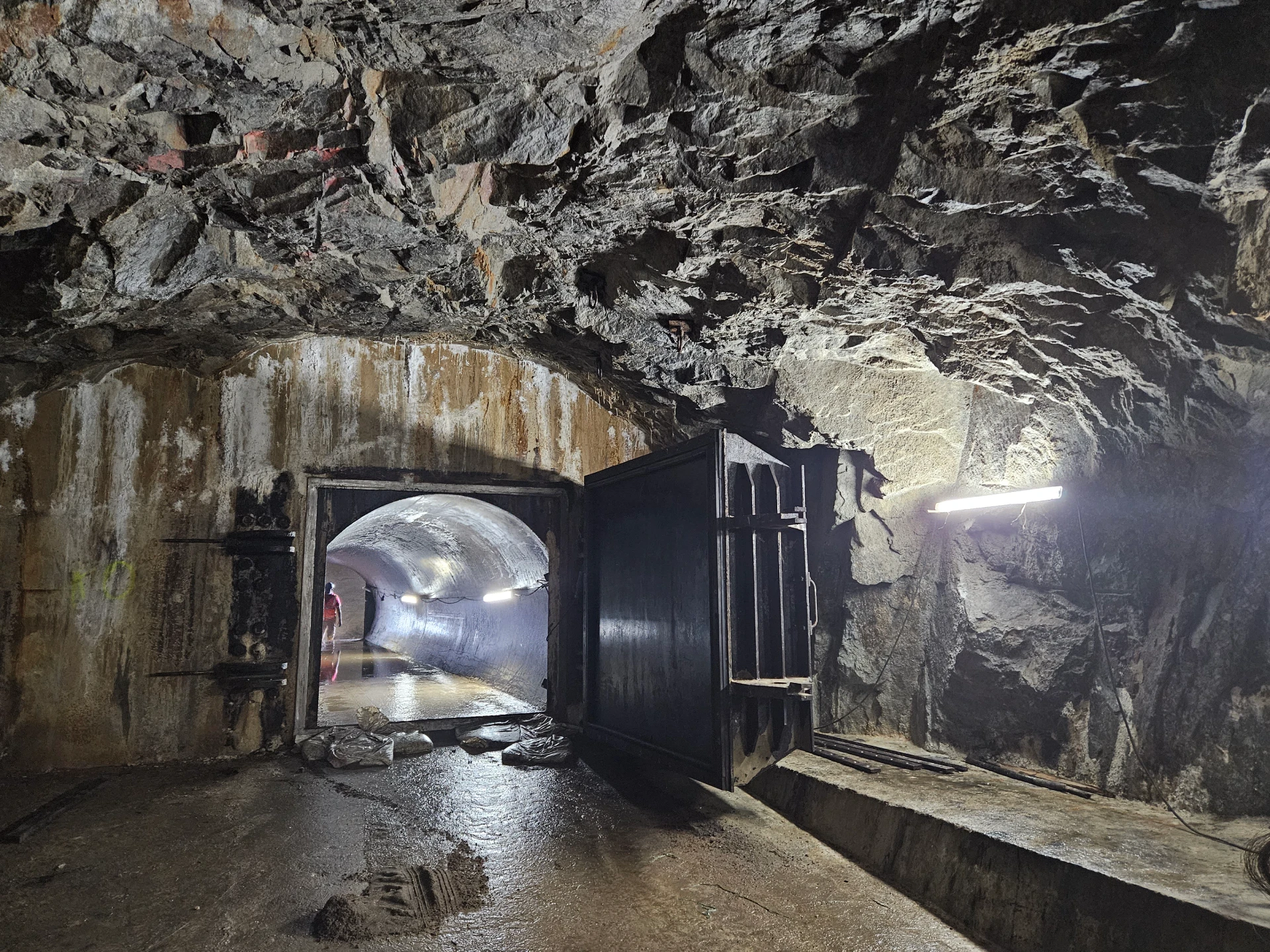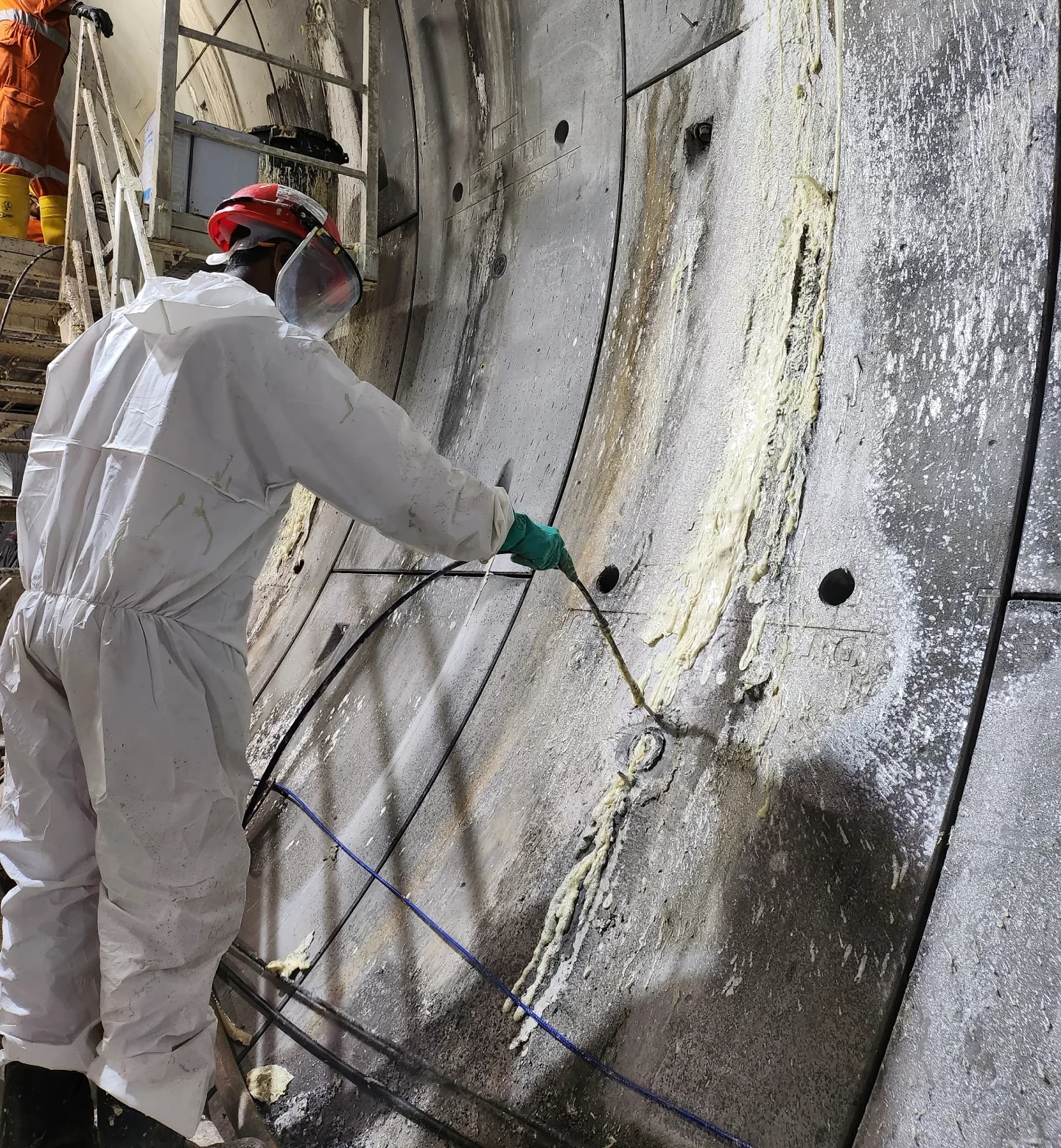PART 1 – INTRODUCTION
Chemical grouting is a common grouting technique used in various construction and rehabilitation projects where the ground is too soft or unstable to support a building or when foundation repairs must be made to existing structures.
When applied under pressure, it fills the cracks within the foundation with flowable grouts to create a cemented mass. If applied correctly, chemical grouting can transform soft granular soil into sandstone-like masses.
However, how does the process work exactly? And what are the benefits and applications of this technique? Let us help clarify these doubts by sharing our comprehensive guide to chemical grouting.
PART 2 – CHEMICAL GROUTING: BENEFITS & APPLICATIONS
2.1. What is Chemical Grouting in Construction
Chemical grouting, also known as permeation grouting, cement grouting, or pressure grouting, is a highly effective grouting solution for construction. This process involves injecting chemical substances into cracks and voids to restore the integrity of soil and concrete structures, enhance waterproofing, and prevent water ingress.
When injected, the grout fills gaps and creates an impermeable mass that enhances the strength and waterproofing of the affected areas. By forming strong bonds with surrounding materials, chemical grouting offers a reliable, durable solution for maintaining the stability of concrete and rock structures.
2.2. What Are The Benefits Of Chemical Grouting?
Chemical grouting is the go-to method for soil stabilisation in construction projects for various reasons. If you are not already using this process, let us share the benefits you stand to gain by switching to chemical grouting over other applications.
Benefit #1: Lower costs
If you have ever overseen a construction project, you will understand that removing and replacing unstable soil entirely is an expensive endeavour that can cause the undertaking to go over budget quickly. Compared to this method, chemical grouting offers a budget-friendly and quicker alternative, allowing companies to save significantly on labour costs.
Benefit #2: Easier application of grout
Soil stabilisation often requires the use of excavators and heavy machinery, most of which might have difficulty accessing construction zones, particularly in urban areas. There is no such worry with chemical grouting, as it only requires a specific piece of equipment to inject the grout, making it the preferred option when space constraint is an issue.
Benefit #3: Minimal disruptions
If you’ve ever had to remove and replace soil, you will know that it is an extremely disruptive and time-consuming process. Furthermore, this can have a knock-on effect on the timeline. Fortunately, chemical grouting can be performed with minimal disruptions to normal facility operations. So, you do not have to worry about delays to your construction project.
Benefit #4: Enhance workplace safety
Some worksites can have soil that easily shifts or slips out of place, creating a safety hazard for your crew and putting any tunnels or trenches at risk of collapse. Applying the correct chemical grout can significantly improve the bearing capacity of granular soil, ensuring it is more robust and stable, thus enhancing workplace safety. Doing so can also prevent groundwater or rainwater from leaking into the construction site.
Benefit #5: Provide structural support and counteract settling
In urban environments like Singapore, it is not uncommon for buildings to settle unevenly, which can increase the risk of structural damage. Chemical grouting helps reduce stress on the structural support beams, providing stability and counteracting settling that can harm the structure’s foundation.
2.3. Applications Of Chemical Grouting
Perhaps the most significant advantage of chemical grouting is its versatility, allowing this technique to be applicable for various construction endeavours, such as the examples provided below.
1. Soil stabilisation
A worksite riddled with weak and unstable soil conditions can be the ultimate bane, not only undermining the entire construction project but also threatening workplace safety. With chemical grouting, a construction crew can enhance the strength and stability of the soil, paving the way for a safer work environment.
2. Foundation repair
Over time, even well-built infrastructures may weaken due to constant exposure to the elements. Applying chemical grout can help stabilise and strengthen their foundations, preventing settlement or upheaval caused by soil movement.
3. Tunnelling and mining
Underground tunnels and mines are especially vulnerable to water infiltration, which can destabilise these vital structures. Chemical grouting offers the ideal solution to seal and preserve the infrastructure, preventing water ingress and enhancing the overall stability of the site.
4. Leak sealing
Likewise, chemical grouting is effective for sealing leaks in various structures, including basements, pipelines, and dams, by creating a watertight barrier, ensuring comprehensive protection against the detrimental effects of water ingress.
5. Dams and embankments
The water-resistant properties afforded by speciality chemical grout also make chemical grouting instrumental in controlling seepage and preventing moisture from penetrating through dams, embankments, and other water-retaining structures, safeguarding the stability and functionality of these critical infrastructures.
6. Infrastructure rehabilitation
As the foundation of ageing or damaged buildings weakens, it poses a significant safety risk to the public. When this happens, a repair crew can leverage chemical grouting to address these challenges, bolstering structural integrity and longevity and upholding the operational resilience of these structures.
7. Void filling
Through strategic application, chemical grouting can be used to effectively address voids and cavities, providing structural support and preventing subsidence.
8. Groundwater control
Chemical grouting is an indispensable technique for controlling and mitigating groundwater flow in construction sites, especially in excavation projects. By precisely controlling groundwater flow, the construction crew can ensure optimal working conditions, thus minimising potential disruptions associated with excess water infiltration and maintaining the project timeline.
PART 3 – UNDERSTANDING CHEMICAL GROUTING
3.1. The Chemical Grouting Process
Now that you have a clear understanding of the benefits of chemical grouting and its various applications, you can see why it is a popular technique within the realm of construction, repair, and moisture prevention. But what does the process entail?
Firstly, it begins with the drilling of a hole into the ground. Afterwards, the work crew will insert a sleeve port pipe into the soil to inject the chemical grout under pressure. As the grout emerges, the solution expands and solidifies, filling the gaps in the soil. As a result, the soil exhibits enhanced durability and reduced permeability.
3.2. The Different Types Of Chemical Grouting
Users have various speciality chemicals to choose from to solve complex issues such as heavy water ingress and structure leakage. Selecting the correct injection material is essential to ensure the solution meets the specific needs of your project. Read on to learn more about the various types of chemical grout available on the market.
1. Polyurethane grout
Polyurethane grout, which is typically made with polyurethane (PU) resin, fine fillers, and water, can be applied to a foundation without having to mix the grout with water, making it a versatile material used in various chemical grouting applications.
Its ability to permeate and solidify loose and unstable ground makes it particularly effective for void filling, soil compaction, and foundation repair. In fact, this PU grouting material is beneficial in situations where traditional methods may be impractical since it can adapt to different soil conditions and is impervious to water infiltration..
2. Acrylic grout
Acrylic grout is primarily used for water control and soil stabilisation. When injected into the ground, the solution provides stability to the surrounding soil and forms a flexible, water-resistant barrier to prevent water ingress.
Its adaptability and durability make acrylic grout especially valuable in scenarios where soil reinforcement and water management are essential. That is why it is often used in undertakings where controlling water flow or stabilising loose soil is critical.
3. Silicate grout
Silicate grout produces a chemical reaction with soil particles, forming a solid mass that enhances soil stability and improves its load-bearing capacity. As a result, this injection material is commonly used to address soil instability and prevent settlement issues in geotechnical engineering and construction projects.
4. Cementitious grout
Comprising a mixture of additives, cement, and water, cementitious grout is often employed for soil stabilisation and void filling to strengthen the ground and increase its load-bearing capacity. In particular, it is a popular choice for tunnelling, mining, and construction projects where the soil requires reinforcement.
5. Microfine cement grout
Microfine cement grout is a specialised injection material designed to infiltrate porous soil, creating a solid mass. Its ability to reach and fill tiny crevices makes it instrumental in improving the overall stability of the ground.
In fact, this grout is often used in soil improvement projects, as the fine particles of microfine cement allow for deeper penetration, resulting in a more uniform and thorough solidification of the targeted area.
6. Epoxy grout
As a high-strength bonding material, epoxy grout provides exceptional adhesion and durability, making it ideal for situations where long-term stability is crucial. As such, it is unsurprising to find epoxy grout commonly used in anchoring bolts, repairing cracks in concrete structures, and stabilising soil in areas where conventional methods may not suffice. In addition, its chemical-resistant properties and capability to withstand significant loads make it a preferred choice for critical structural reinforcement projects.
7. Sodium silicate grout
As it shares an identical compound with silicate grout, sodium silicate grout also produces a similar reaction with minerals in the soil to create a solid mass, offering long-lasting stability to the ground. However, the difference between the two injection materials lies in the latter’s ability to enhance the load-bearing capacity of the ground while allowing for water permeability.
3.3. Different Types of Grouting in Tunnel Works
Just like several types of injection grout materials are available on the market, there are different application methods for chemical grouting, each with its specific purpose and aim. Let us detail each process so that you can have a better understanding of the various procedures.
1. Permeation Grouting
Permeation grouting involves injecting a low-viscosity grout into the soil to enhance its properties. This process is usually employed to improve the cohesion of the soil or for void filling. The aim is to permeate the soil with the grout solution, addressing issues related to its stability and structure.
2. Compaction Grouting
In compaction grouting, a thick, mortar-like grout is injected into the soil to displace and compact the surrounding materials, creating a denser soil matrix to enhance load-bearing capabilities and ensure the integrity of the treated area. As a result, this method is particularly effective for lifting and stabilising structures.
3. Curtain Grouting
The aim of curtain grouting is to create a grout curtain to either block water flow or stabilise the soil. As part of the process, the grout will be applied along the perimeter of the structure to form a barrier, preventing water infiltration and safeguarding against potential issues arising from water seepage.
4. Jet Grouting
Jet grouting involves the high-pressure injection of grout through a nozzle into the soil to create a soil-cement column. The formation of these cementitious columns helps improve structural support and stability, making it a commonly utilised technique for foundation support and soil mixing.
5. Injection Wells
The injection wells method involves installing wells through which the grout solution can be directly injected into the soil at various depths. This approach provides users with precise control over the grouting process and enables efficient treatment of expansive soil volumes, making it ideal for treating large areas or deep soil layers.
6. Soil Fracturing
As its name implies, soil fracturing entails creating fractures in the soil by injecting grout under high pressure. Doing so improves permeability and elevates load-bearing capacity. The strategic usage of this method can also help address issues pertaining to compaction and stability, making it valuable for geotechnical applications.
7. Compaction Piles
Compaction piles are often employed in foundation work to preserve structural integrity by providing enhanced support and minimising settlement risks. As part of the process, the work crew will drill holes and fill them with grout to create compacted columns in the soil. Doing so helps improve load-bearing capacity and stabilises the surrounding soil.
8. Void Filling
Void filling is an injection method primarily used for tasks such as filling tunnels or mine shafts. Grout is injected into the voids or gaps in the soil to effectively plug these crevices, ensuring the integrity of the surrounding soil and mitigating potential issues associated with hollow spaces.
9. Pressure Grouting
Pressure grouting, the process of applying grout under pressure to fill cracks and voids or improve soil structure, ensures thorough penetration and distribution of the grout, making it suitable for various applications, ranging from foundation repair to strengthening existing infrastructures.
10. Slab Jacking
Slab jacking is a method of lifting concrete slabs by injecting grout underneath. This process is usually employed for levelling and repairing uneven or sunken slabs. By raising them to their desired level, slab jacking helps address issues related to settlement and offers a cost-effective solution for restoring the aesthetics and functionality of concrete surfaces.
11. Polyurethane Injection Grouting
Polyurethane injection grouting is often used in tunnel grouting solutions to seal cracks and voids effectively. By injecting a two-component polyurethane mixture, the grout expands upon contact with water, filling gaps and forming a watertight seal. This grouting solution for construction is particularly effective in tunnels, where water ingress is a common issue, providing long-lasting protection from moisture and preventing further structural deterioration.
12. Chemical Soil Stabilization
This method involves the injection of stabilising chemicals that bind and strengthen the soil around tunnels, making it more resistant to water infiltration and improving its load-bearing capacity. Chemical soil stabilisation is often used in tunnels located in areas with soft or unstable ground, enhancing structural integrity and ensuring the long-term stability of the tunnel system.
13. Grout Injection Under Pressure (Packer Injection)
This technique involves using injection packers to inject grout into pre-drilled holes under high pressure. It is widely used in tunnel construction to seal joints and cracks. This method ensures that grout reaches the exact location of the damage, creating a strong seal and preventing water from entering the tunnel.
14. Foam Grouting
Foam grouting is a lighter, low-density injection method used to seal larger voids in tunnel structures. The foam grout is injected under pressure, where it expands to fill the cavity. The foam’s lightweight nature makes it suitable for areas where minimal weight is preferred, while still providing excellent sealing properties against water ingress.
3.4. Step-By-Step Procedure For Applying Chemical Grout
Are you unsure of the best way to apply chemical grout for your construction project? Fret not! Here is a step-by-step guide for your reference.
Step #1: Assess the worksite
Before commencing your project, it is recommended to conduct a thorough assessment of the construction site, including the soil condition, structure type, and the location of any voids or instabilities.
Step #2: Select the appropriate grout
The evaluation of the worksite is essential, as its conditions, such as the soil characteristics, can impact your project requirements. That, in turn, affects your choice of chemical grout.
Learn More: Top 4 Grout Types: How To Choose The Right One For The Job
Step #3: Determine your port placement
Your assessment of the site will also help determine the optimal locations for your injection ports. Remember, the ports should be spaced strategically to ensure even grout distribution.
Step #4: Drill the ports
Once you’ve decided on the ideal port placement, drill holes at each selected port location with a suitable drilling method. The size and depth of these holes depend on your project specifications.
Step #5: Install the ports
Subsequently, insert the injection ports into the drilled holes. They will function as a conduit for the grout to reach the targeted areas.
Step #6: Conduct pre-grouting testing
Always conduct pre-grouting tests beforehand to assess the response and permeability of the soil. This way, you can determine the correct injection pressure and grout flow rate to apply.
Step #7: Mix the grout
After ascertaining the appropriate pressure and flow rate to use, you can proceed to mix the grout. Please adhere to the manufacturer’s instructions when preparing the chemical grout and ensure you combine the solution properly to achieve the desired consistency and properties.
Step #8: Inject the grout
Connect your injection equipment to the ports to begin injecting the grout. We recommend starting with the port furthest from the injection source and gradually working your way towards it.
Step #9: Monitor the situation and make adjustments accordingly
Remember to constantly monitor the injection pressure, flow rate, and site conditions while injecting the grout, and make adjustments accordingly to optimise grout distribution.
Step #10: Complete the grouting process and clean up the site
Once you’ve applied the desired grout volume and achieved soil stabilisation, complete the process by removing the injection equipment and sealing or plugging the ports. Afterwards, clean and restore the site as necessary.
Step #11: Conduct a post-grouting inspection
Lastly, conduct a post-grouting inspection of the site to assess the treatment’s effectiveness, paying attention to any signs of soil movement or structural changes.
Please note that the steps listed are meant to be a broad outline of the process, and they may vary based on your chosen chemical grouting method and project requirements.
PART 4 – CONCLUSION
Evidently, chemical grouting presents a versatile and effective solution to address soil instability, preserve structural integrity, and prevent water ingress. Furthermore, its adaptability to various applications and cost-effectiveness further cements this process as a preferred choice in numerous construction projects. As grouting technologies continue to advance, we believe chemical grouting is poised to play a more significant role in future geotechnical engineering and construction undertakings.
At Adcos Asia, we provide a comprehensive range of speciality chemical grout products to tackle complex, problematic foundation and leak-sealing issues, offering flexibility, adaptation, and customisation to meet varying business requirements. Contact us today to learn how we can help address the specific needs of your construction project.















 ADCOS Asia
ADCOS Asia